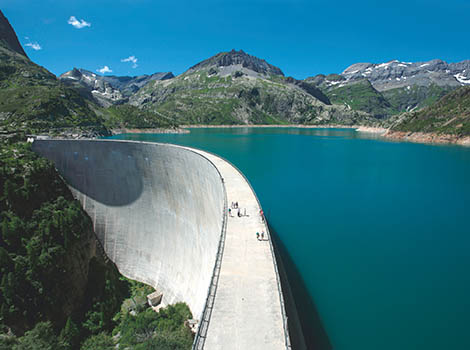Hydroelectricity is not the ageing science that people think it is. Nowadays, hydroelectric machines are high-technology objects that have to satisfy increasingly stringent flexibility, performance and endurance criteria. Grenoble INP boasts a high level of resources and expertise to take part in developing the turbines of the future.

Due to the increase of intermittent renewable energy sources such as wind power and solar energy in the energy mix, compensatory methods must now be found to guarantee the stability of the power grid. Hydroelectricity is the ideal solution as the fluctuations of solar or wind power generation, for example, may be compensated by the commissioning of hydroelectric power plants. Furthermore, this is the only method currently available for storing large amounts of energy thanks to the pump storage power stations (PSPS) that comprise an upper reservoir and a lower reservoir connected by a hydroelectrical power unit. The PSPSs are able to store energy when consumption is low and can be actuated over short periods of time. On account of this, they can be a back-up solution during peak load use and offer a 1,000 MW storage capacity that far exceeds that of a conventional battery.
A changing science
Hydroelectricity, which is now burgeoning, represents 14% of France’s electricity generation, behind nuclear energy (73%) and way ahead of solar energy and wind power (5%). Hydraulic energy provides 16% of the world’s energy needs. “Even though in Europe and North America, renovation of the existing power plants constitutes the bulk of the market, there are still many sites to be equipped across the world with only a third of the world’s resources being currently tapped”, explained Olivier Métais, professor at Grenoble INP – Ense3 and researcher at LEGI. To address these challenges, manufacturers such as Alstom are at work developing machines that meet the new requirements. As a matter of fact, the existing machines were designed to operate for the most part at a rate close to the optimum performance. “Instabilities appear in the remote operating zones thereby subjecting the turbine or the pump to significant mechanical stresses that may result in shortened service lives”. Today’s turbines must be flexible with extremely extended operating ranges as the goal is for them to be able to be started and stopped more frequently and to be able to constantly adjust the energy transmitted to the grid. To meet these challenges, scientists have put together their skills and expertise in major multi-disciplinary research projects such as for instance Innov’hydro, the structuring project of the competitive clusters (PSPC).

Due to the increase of intermittent renewable energy sources such as wind power and solar energy in the energy mix, compensatory methods must now be found to guarantee the stability of the power grid. Hydroelectricity is the ideal solution as the fluctuations of solar or wind power generation, for example, may be compensated by the commissioning of hydroelectric power plants. Furthermore, this is the only method currently available for storing large amounts of energy thanks to the pump storage power stations (PSPS) that comprise an upper reservoir and a lower reservoir connected by a hydroelectrical power unit. The PSPSs are able to store energy when consumption is low and can be actuated over short periods of time. On account of this, they can be a back-up solution during peak load use and offer a 1,000 MW storage capacity that far exceeds that of a conventional battery.
A changing science
Hydroelectricity, which is now burgeoning, represents 14% of France’s electricity generation, behind nuclear energy (73%) and way ahead of solar energy and wind power (5%). Hydraulic energy provides 16% of the world’s energy needs. “Even though in Europe and North America, renovation of the existing power plants constitutes the bulk of the market, there are still many sites to be equipped across the world with only a third of the world’s resources being currently tapped”, explained Olivier Métais, professor at Grenoble INP – Ense3 and researcher at LEGI. To address these challenges, manufacturers such as Alstom are at work developing machines that meet the new requirements. As a matter of fact, the existing machines were designed to operate for the most part at a rate close to the optimum performance. “Instabilities appear in the remote operating zones thereby subjecting the turbine or the pump to significant mechanical stresses that may result in shortened service lives”. Today’s turbines must be flexible with extremely extended operating ranges as the goal is for them to be able to be started and stopped more frequently and to be able to constantly adjust the energy transmitted to the grid. To meet these challenges, scientists have put together their skills and expertise in major multi-disciplinary research projects such as for instance Innov’hydro, the structuring project of the competitive clusters (PSPC).
SUMMARY
- Imagining the hydraulic machines of the future
- Hydroelectricity: an energy of the future
- Innov'hydro: a multi-disciplinary project
- "We will not be the best on our own"
- Tidal turbines in rivers and at sea
- LCIS transforms RFID labels into sensors
- Micro hydropower plants to provide rural areas with electricity





